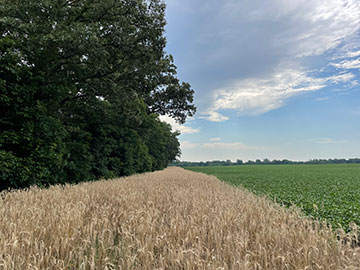Double benefit
Aug 21, 2023

Tennessee Quail Forever is known for its efforts to promote conservation methods to enhance the habitat of upland birds and other wildlife. Since spring of 2021, the organization has been working with farmers to use precision agriculture tools to identify unprofitable portions of fields and assist them in converting these areas to wildlife habitat. The effort has the potential to improve conservation efforts, while helping farmers improve their return on investment.
There are problem areas in many fields — perhaps the edges of a field next to a big oak tree or at a spring-fed wet spot where producers notice a drop in production. Yield monitors help us to identify these areas. These “marginal” areas often do not produce enough yield to meet or exceed seed, chemical, fertilizer, diesel, and other costs, making the portion of the plot unprofitable.
Quail Forever, in partnership with the Natural Resources Conservation Service and Tennessee Wildlife Resources Agency, supports a precision agriculture initiative in Tennessee that aims to help row crop farmers and landowners boost farm productivity by shifting those low-producing, unprofitable acres into managed wildlife habitat. Quail Forever’s Precision Agriculture and Conservation Specialists are available to partner with producers free of charge to help farmers evaluate yield data collected over several years to identify acres that can potentially improve wildlife habitat and reduce financial risk. Money lost annually in these areas is saved and redistributed over the rest of the field to increase overall return-on-investment. It’s the farmer’s ability to be more profitable on less acreage and improve cover and food availability for bobwhite quail and other wildlife that makes it a win-win for everyone. Producers and landowners also have access to several state and federal conservation programs that could provide cost-share and/or incentive payments to enroll acres, making it even more financially viable for wildlife habitat to play a role in their operation.
Often, a seed mix of native warm-season grasses, wildflowers, and legumes is planted and managed periodically with burning, light disking, and/or herbicide to promote native flowering plants and legumes, while also keeping invasive weeds and saplings from encroaching. These same plant communities have been shown to provide adequate food and shelter for bobwhite quail and have the potential to improve water quality, reduce soil erosion, sequester carbon, and house beneficial insect populations.
Even though this isn’t a new practice to the farming community, these methods are often underused because most farmers don’t have the time to sort through acres and acres of data to understand exactly how much money is being lost. It gives the technology they pay for and keep updated another useful purpose and provides another tool for improving profitability.
If you would like to learn more about Pheasants Forever, Inc. and Quail Forever, and the organization’s conservation efforts, contact Jacob Taylor at (877) 773-2070 or on mobile at (731) 487-2234 or email at jtaylor@quailforever.org.
There are problem areas in many fields — perhaps the edges of a field next to a big oak tree or at a spring-fed wet spot where producers notice a drop in production. Yield monitors help us to identify these areas. These “marginal” areas often do not produce enough yield to meet or exceed seed, chemical, fertilizer, diesel, and other costs, making the portion of the plot unprofitable.
Quail Forever, in partnership with the Natural Resources Conservation Service and Tennessee Wildlife Resources Agency, supports a precision agriculture initiative in Tennessee that aims to help row crop farmers and landowners boost farm productivity by shifting those low-producing, unprofitable acres into managed wildlife habitat. Quail Forever’s Precision Agriculture and Conservation Specialists are available to partner with producers free of charge to help farmers evaluate yield data collected over several years to identify acres that can potentially improve wildlife habitat and reduce financial risk. Money lost annually in these areas is saved and redistributed over the rest of the field to increase overall return-on-investment. It’s the farmer’s ability to be more profitable on less acreage and improve cover and food availability for bobwhite quail and other wildlife that makes it a win-win for everyone. Producers and landowners also have access to several state and federal conservation programs that could provide cost-share and/or incentive payments to enroll acres, making it even more financially viable for wildlife habitat to play a role in their operation.
Often, a seed mix of native warm-season grasses, wildflowers, and legumes is planted and managed periodically with burning, light disking, and/or herbicide to promote native flowering plants and legumes, while also keeping invasive weeds and saplings from encroaching. These same plant communities have been shown to provide adequate food and shelter for bobwhite quail and have the potential to improve water quality, reduce soil erosion, sequester carbon, and house beneficial insect populations.
Even though this isn’t a new practice to the farming community, these methods are often underused because most farmers don’t have the time to sort through acres and acres of data to understand exactly how much money is being lost. It gives the technology they pay for and keep updated another useful purpose and provides another tool for improving profitability.
If you would like to learn more about Pheasants Forever, Inc. and Quail Forever, and the organization’s conservation efforts, contact Jacob Taylor at (877) 773-2070 or on mobile at (731) 487-2234 or email at jtaylor@quailforever.org.